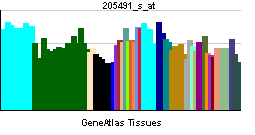GJB3
| Gap junction protein, beta 3, 31kDa | |||||||||||
|---|---|---|---|---|---|---|---|---|---|---|---|
| Identifiers | |||||||||||
| Symbols | GJB3 ; CX31; DFNA2; EKV; FLJ22486; MGC102938 | ||||||||||
| External IDs | Template:OMIM5 Template:MGI HomoloGene: 7338 | ||||||||||
| |||||||||||
| RNA expression pattern | |||||||||||
 | |||||||||||
 | |||||||||||
 | |||||||||||
| More reference expression data | |||||||||||
| Orthologs | |||||||||||
| Template:GNF Ortholog box | |||||||||||
| Species | Human | Mouse | |||||||||
| Entrez | n/a | n/a | |||||||||
| Ensembl | n/a | n/a | |||||||||
| UniProt | n/a | n/a | |||||||||
| RefSeq (mRNA) | n/a | n/a | |||||||||
| RefSeq (protein) | n/a | n/a | |||||||||
| Location (UCSC) | n/a | n/a | |||||||||
| PubMed search | n/a | n/a | |||||||||
Gap junction protein, beta 3, 31kDa, also known as GJB3, is a human gene.[1]
This gene is a member of the connexin gene family. The encoded protein is a component of gap junctions, which are composed of arrays of intercellular channels that provide a route for the diffusion of low molecular weight materials from cell to cell. Mutations in this gene can cause non-syndromic deafness or erythrokeratodermia variabilis, a skin disorder. Alternative splicing results in multiple transcript variants encoding the same protein.[1]
References
Further reading
- Coucke P, Van Camp G, Djoyodiharjo B; et al. (1994). "Linkage of autosomal dominant hearing loss to the short arm of chromosome 1 in two families". N. Engl. J. Med. 331 (7): 425–31. PMID 8035838.
- Van Camp G, Coucke PJ, Kunst H; et al. (1997). "Linkage analysis of progressive hearing loss in five extended families maps the DFNA2 gene to a 1.25-Mb region on chromosome 1p". Genomics. 41 (1): 70–4. doi:10.1006/geno.1997.4624. PMID 9126484.
- Wenzel K, Manthey D, Willecke K; et al. (1998). "Human gap junction protein connexin31: molecular cloning and expression analysis". Biochem. Biophys. Res. Commun. 248 (3): 910–5. doi:10.1006/bbrc.1998.9070. PMID 9704026.
- Richard G, Smith LE, Bailey RA; et al. (1998). "Mutations in the human connexin gene GJB3 cause erythrokeratodermia variabilis". Nat. Genet. 20 (4): 366–9. doi:10.1038/3840. PMID 9843209.
- Xia JH, Liu CY, Tang BS; et al. (1998). "Mutations in the gene encoding gap junction protein beta-3 associated with autosomal dominant hearing impairment". Nat. Genet. 20 (4): 370–3. doi:10.1038/3845. PMID 9843210.
- Liu XZ, Xia XJ, Xu LR; et al. (2000). "Mutations in connexin31 underlie recessive as well as dominant non-syndromic hearing loss". Hum. Mol. Genet. 9 (1): 63–7. PMID 10587579.
- Wilgoss A, Leigh IM, Barnes MR; et al. (2000). "Identification of a novel mutation R42P in the gap junction protein beta-3 associated with autosomal dominant erythrokeratoderma variabilis". J. Invest. Dermatol. 113 (6): 1119–22. doi:10.1046/j.1523-1747.1999.00792.x. PMID 10594760.
- Kelsell DP, Wilgoss AL, Richard G; et al. (2000). "Connexin mutations associated with palmoplantar keratoderma and profound deafness in a single family". Eur. J. Hum. Genet. 8 (2): 141–4. doi:10.1038/sj.ejhg.5200407. PMID 10757647.
- López-Bigas N, Rabionet R, Martínez E; et al. (2000). "Identification of seven novel SNPS (five nucleotide and two amino acid substitutions) in the connexin31 (GJB3) gene". Hum. Mutat. 15 (5): 481–2. doi:10.1002/(SICI)1098-1004(200005)15:5<481::AID-HUMU15>3.0.CO;2-7. PMID 10790215.
- Richard G, Brown N, Smith LE; et al. (2000). "The spectrum of mutations in erythrokeratodermias--novel and de novo mutations in GJB3". Hum. Genet. 106 (3): 321–9. PMID 10798362.
- López-Bigas N, Olivé M, Rabionet R; et al. (2001). "Connexin 31 (GJB3) is expressed in the peripheral and auditory nerves and causes neuropathy and hearing impairment". Hum. Mol. Genet. 10 (9): 947–52. PMID 11309368.
- Gottfried I, Landau M, Glaser F; et al. (2002). "A mutation in GJB3 is associated with recessive erythrokeratodermia variabilis (EKV) and leads to defective trafficking of the connexin 31 protein". Hum. Mol. Genet. 11 (11): 1311–6. PMID 12019212.
- Nielsen PA, Beahm DL, Giepmans BN; et al. (2002). "Molecular cloning, functional expression, and tissue distribution of a novel human gap junction-forming protein, connexin-31.9. Interaction with zona occludens protein-1". J. Biol. Chem. 277 (41): 38272–83. doi:10.1074/jbc.M205348200. PMID 12154091.
- Di WL, Monypenny J, Common JE; et al. (2003). "Defective trafficking and cell death is characteristic of skin disease-associated connexin 31 mutations". Hum. Mol. Genet. 11 (17): 2005–14. PMID 12165562.
- Diestel S, Richard G, Döring B, Traub O (2002). "Expression of a connexin31 mutation causing erythrokeratodermia variabilis is lethal for HeLa cells". Biochem. Biophys. Res. Commun. 296 (3): 721–8. PMID 12176042.
- Strausberg RL, Feingold EA, Grouse LH; et al. (2003). "Generation and initial analysis of more than 15,000 full-length human and mouse cDNA sequences". Proc. Natl. Acad. Sci. U.S.A. 99 (26): 16899–903. doi:10.1073/pnas.242603899. PMID 12477932.
- Mhatre AN, Weld E, Lalwani AK (2003). "Mutation analysis of Connexin 31 (GJB3) in sporadic non-syndromic hearing impairment". Clin. Genet. 63 (2): 154–9. PMID 12630965.
- Rouan F, Lo CW, Fertala A; et al. (2004). "Divergent effects of two sequence variants of GJB3 (G12D and R32W) on the function of connexin 31 in vitro". Exp. Dermatol. 12 (2): 191–7. PMID 12702148.
- Plantard L, Huber M, Macari F; et al. (2004). "Molecular interaction of connexin 30.3 and connexin 31 suggests a dominant-negative mechanism associated with erythrokeratodermia variabilis". Hum. Mol. Genet. 12 (24): 3287–94. doi:10.1093/hmg/ddg364. PMID 14583444.
- Gerhard DS, Wagner L, Feingold EA; et al. (2004). "The status, quality, and expansion of the NIH full-length cDNA project: the Mammalian Gene Collection (MGC)". Genome Res. 14 (10B): 2121–7. doi:10.1101/gr.2596504. PMID 15489334.
| This protein-related article is a stub. You can help Wikipedia by expanding it. |